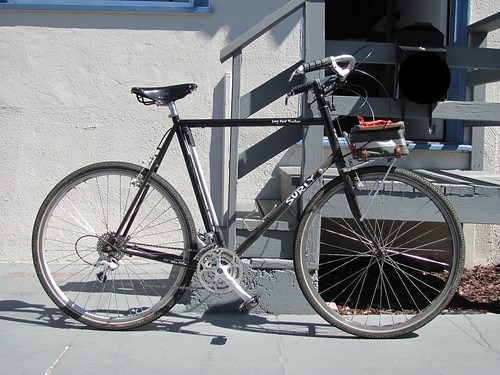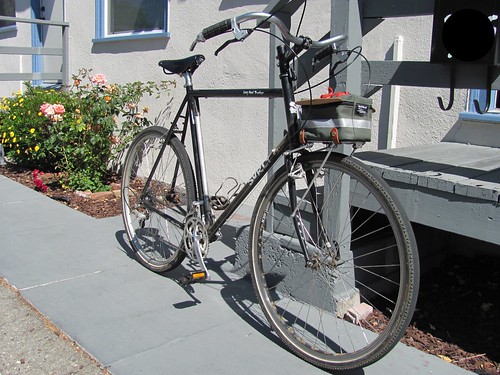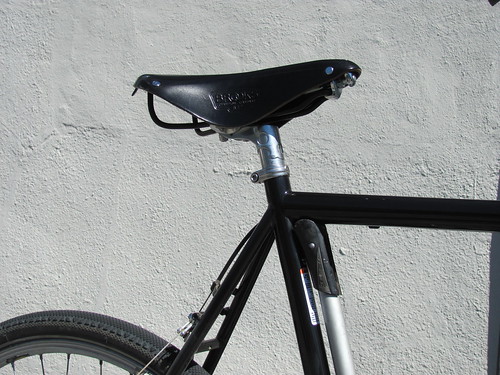
Time to do a post outlining the latest addition to my stable: my 64cm Surly Long Haul Trucker, built by me around a 2013 frame.
Back story on this bike: my oldest bike, which hasn't featured much on this blog so far, is my Trek 520 touring bike. This was my first "serious" bike, bought in 2002 from Belmont Wheelworks near Boston, for the purposes of a summer coast-to-coast bike trip with an Overland touring group. It was the bike on which I fell in love with cycling, and after the trip it followed me to college, where it helped me discover the joys of riding in the San Francisco Bay Area. Over the course of it's life, I had tore it down in rebuilt any number of times, each time with a different configuration. This past spring, wanting to do a geared, upright-bar build for mixed-terrain riding, I was tearing it down and planning to rebuild it yet again. Unfortunately, as I outlined in a previous post, while removing the blown headset I discovered cracks in the headtube, leaving me in need of a another frame for my build.
Enter the Long Haul Trucker. It was an easy choice, really: being a steel, 700c touring bike designed for cantilever brakes, it would easily accept all of the parts I had intended for the Trek, save the headset (the Trek had a 1" threadless steerer, the Surly a 1 1/8"). It is also readily available as a frameset. I had also recently built up one of the complete bikes for a friend recently and was impressed with the quality of the frame, which was very high compared to a lot of mass-produced bicycles at simliar price points. Checking out the geometry, it seemed like it would work well for my preferences. Since this bicycle was going to be based on my experience riding upright bars on my 64cm Quickbeam, I was drawn towards the recently added 64cm size. Comparing the bikes, they have similar angles--72 degrees parallel on the Trucker, and 72 degree seat/72.5 degree head on the Quickbeam. The similar seat angle in particular was good: combined with the standard 27.2mm seatpost spec, I could use the same Nitto S-84 seatpost to get my seat in the wayback position I've been preferring. Other than that, the Trucker had a slightly longer TT compared to the Quickbeam (61.5cm vs. 60cm), which didn't really concern me since I knew I would be using swept-back bars and I could always use a slightly shorter stem to dial in the reach. I also like the extended headtube, another feature it shared with Rivendell bikes.
So, the Trucker frame was ordered and received in short order. Building it up, I really appreciated how well the frame had been prepped and the overall quality of the frame and finish work. The headset pressed in easily with no fuss, the bottom bracket threads were totally clean and the BB threaded in perfectly, and the seatpost fit just right. The build was completely straightforward, finished in just a few nights of after-work sessions.

The build:
Frame/Fork: 2013 Surly Long Haul Trucker, 64cm, 700c w/ Cantilever brakes. Color is "Blacktacular."
Headset: Cane Creek 40, 1 1/8" Threadless
Handlebars: Nitto Albatross Chromoly, 55cm wide.
Stem: Dimension 110mm, plus 17 degrees (may flip that), 25.4mm clamp
Front Cable Housing Stop: Origin 8. Has pinch bolt and barrell adjuster, easily clears the headset even when placed just above the top bearing cover.
Saddle: Brooks B. 17 Champion Standard, Black
Seatpost: Nitto S-84, 27.2mm.
Seatpost Clamp: Surly (comes with frame)
Cranks: Sugino XD2 Triple, 28-36-48
Bottom Bracket: Shimano UN-? (I think it's a -54), 113mm
Wheels: Older Shimano LX hubs. Front rim is a Bontrager Maverick, rear is Mavic T520. 32F/36R.
Tires: Continental Cyclocross Speed 700x42c, originally on my Quickbeam. These are great all-rounder tires.
Cassette: SRAM PG 850 8spd, 11-32
Chain: SRAM PC 830
Front Derailleur: Shimano FD-2303 8spd road triple, 28.6mm clamp.
Rear Derailleur: Sachs Quarz (esoteric component points!)
Shifters: Shimano Dura-Ace 9spd bar-end shifters, running in friction mode.
Brakes: Tektro CR-720 Cantilevers
Brake Levers: Origin-8 Flat Bar levers w/ adjustable cable pull.
Pedals: Diamondback Sound BMX pedals
Front Rack: Nitto M-18 ("Mark's Rack"), four strut mounting with extra long struts for the lowrider braze-ons.
Front Bag: Rivendell Sackville TrunkSack Small

I've been riding the bike for a few weeks now and feel like I've hit all of my design goals with the build. It is a great riding and very capable bike, the upright bars and wide range gearing keeping me comfortable on long hilly rides. The only slight hiccup at the beginning was with a component spec, not the frame or build. Originally, wanting to assure that I wasn't limited in setback, I sourced a vintage ITM MTE-100 adjustable-setback seatpost, and this was the seatpost I used at first. However, I quickly discovered that the ITM was a true single-bolt micro-adjust post, lacking any kind of indexing teeth to help maintain the rail angle adjustment. Unfortunately, with my 220lb+ bulk and upright riding position, it wasn't up to the task of holding the angle, and riding over bumps would leave the nose of my saddle pointing further skyward than I had set it. So, off came that post and I swapped in the S-84 that had previously lived on my Casseroll (I'll need to figure out another seatpost arrangement for that soon). While I'm always concerned about having enough setback, the truth is that with a Brooks saddle and relatively upright riding position, the combination of 72 degree seat tube angle and the ~40mm offset S-84 is "just right" in terms of saddle setback for me.

The upright bars have also worked really well. The main grips position is so dang comfortable, I find myself staying there for a long time. It also offers really good control off-road. I do find myself sliding my hands forward sometimes on long climbs, to stretch out or balance the traction a bit better. Like the Quickbeam, they keep my head up and looking around, enjoying the scenery. However, I can also say for sure that there is a definite difference between the Albatross bars and the Bosco bars on the Quickbeam. Both are basically swept-back bars for achieving an upright riding position, but the Boscos are considerably roomier than the Albatross, offering a greater variety of hand positions and back angles. I am also more upright in the Bosco primary position than in the current Albatross position on the Trucker. Ironically, I also find it easier to get aero on the Boscos: with my hands on the grips, I can lean basically all of the way forward and tuck into kind of a ski racer position, with my arms completely folded. I have the Albatross grips set a bit lower and at a little bit more of an angle, which puts the grip at a really nice angle for my hands when seated. However, when I'm trying to get into an aero tuck on the Albatrosses, the slightly lower position and angle means that my arms are deeply bent but not completely folded, meaning I have to use my arm muscle to maintain this position, which can be fatiguing. I noticed this yesterday as I was coming back on Wildcat Canyon Rd., which is slightly downhill heading back into Berkeley. However, this is with the Albatrosses as I currently have them set, and I have some ideas about changing their angle and position which might help.

The best thing about this bike, and definitely one of my main design goals, is the ability to be equally at home on- and offroad. The gearing and position, as well as the fat 42mm rubber I'm easily able to run, has allowed me to start comfortably exploring much more of the riding the East Bay hills have to offer. This bike has taken me up and down some beautiful and secluded fire roads and singletrack, handling the rough and steep stuff with aplomb. It served me well on the epic mixed-terrain ride from Fremont to Berkeley I described in the last post. I had been over some of this same ground before, but rarely. I had even done some on the Casseroll, but that was a bit too white-knuckled to be really enjoyable. The Quickbeam is also a capable offroad machine, but it's single gearing takes some commitment to get up a lot of the hills around here. The Trucker handles all of this comfortably, and is probably all the "mountain bike" I'll ever really need. Sure, over some of the really washboarded and rocky sections of trail, wider tires and maybe even suspension would make the ride smoother, but at no point have I felt that the Trucker wasn't capable of handling whatever I could throw at it.
Back at the beginning of this blog last year, I had talked about wanting to introduce more variety into my riding, thinking about mountain biking. I think the Trucker is finally getting me to that place, of allowing me to take different kinds of rides, approach things differently than simply transportation or road rides. I'm not sure it's the "one" bike for me--in fact, as I'm writing this I'm thinking about rolling out the Casseroll again, trying some new things with that. But I'm happy to have three really awesome and different bikes to work with in my stable.
Have you thought about flipping the bars over? The cross-bar becomes more usable. It might be worthwhile if you are sliding forward on the bars a lot since you have more of the steering tube available. You'll probably need to raise the bar more and point the bars towards the rear wheel.
ReplyDeleteOh ... if you're looking for a 27.2 seatpost with a lot of setback, I have been happy with the VO long setback seatpost.
ReplyDelete